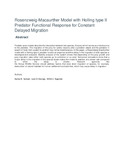| dc.contributor.author | Samuel, Apima B. | |
| dc.contributor.author | George, Lawi O. | |
| dc.contributor.author | Kagendo, Nthiiri J. | |
| dc.date.accessioned | 2021-06-09T12:53:44Z | |
| dc.date.available | 2021-06-09T12:53:44Z | |
| dc.date.issued | 2019-08-29 | |
| dc.identifier.uri | https://doi.org/10.9734/arjom/2019/v15i130140 | |
| dc.identifier.uri | https://www.journalarjom.com/index.php/ARJOM/article/view/30140 | |
| dc.identifier.uri | http://ir-library.mmust.ac.ke/123456789/1679 | |
| dc.description.abstract | Predator-prey models describe the interaction between two species, the prey which serves as a food source to the predator. The migration of the prey for safety reasons after a predator attack and the predator in search of food, from a patch to another may not be instantaneous. In this paper, a Rosenzweig-MacAurther model with a Holling-type II predator functional response and time delay in the migration of both species is developed and analysed. Stability analysis of the system shows that depending on the prey growth and prey migration rates either both species go to extinction or co-exist. Numerical simulations show that a longer delay in the migration of the species leads makes the model to stabilize at a slower rate compared to when the delay is shorter. Relevant agencies like
the Kenya Wildlife Service should address factors that slow down migration of species, for example, destruction of natural habitats for human settlement and activities, which may cause delay in migration. | en_US |
| dc.language.iso | en | en_US |
| dc.publisher | Asian Research Journal of Mathematics | en_US |
| dc.subject | Rosenzweig,Macaurther, Model, Holling, type II ,Predator, Functional, Response, Constant,Delayed, Migration | en_US |
| dc.title | RosenzweigMacAurther Model with Holling type II Predator Functional Response for Constant Delayed Migration. Asian Research Journal of Mathematics | en_US |
| dc.type | Article | en_US |

